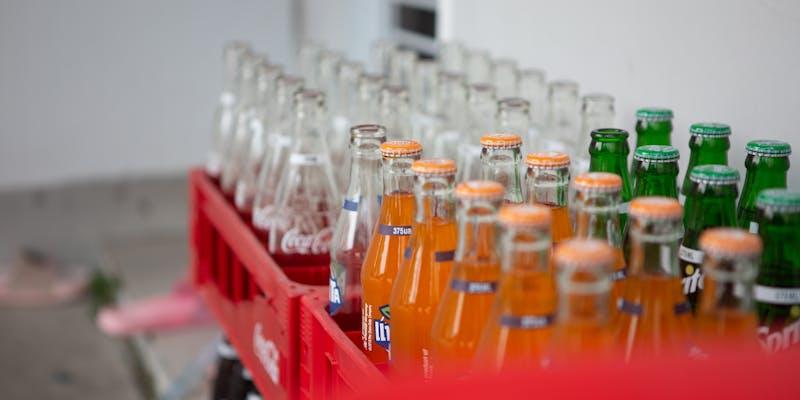What Does It Mean by Carbonic Acid in Drinks?
Feb 21, 2024 By Madison Evans
Carbonic acid, an acidic molecule in carbonated beverages, undergoes decomposition upon activating a carbonated beverage can or bottle. Typical soda carbonation is generated during the carbonic acid decomposition process. There is no evidence that carbonic acid formula in beverages is harmful despite the acidic nature of the substance.
What is Carbonic Acid?
Carbonic acid, which is composed of carbon, is that which is present in solutions of carbon dioxide in water. The substance H2CO3 indicates its composition, which includes a single carbon atom double-bonded to an oxygen atom and two hydroxyl groups appended to the carbon atom. The structure can also be represented as OC(OH)2, emphasizing the carbon-oxygen double bond.
Particular attention is paid to this acid in discussions regarding respiration since it is the only acid expelled as a gas through the lungs. Significant in the formation of carbonate and bicarbonate compounds, it is characterized by its weak acid nature. Carbonic acid possesses the intriguing property of forming calcium bicarbonate, Ca(HCO3)2, upon dissolving limestone. This reaction is essential to developing numerous limestone features, including stalagmites and stalactites, illustrating the acid's effect on geological carbonic acid formulas.
Reaction of Carbonic Acid
According to the structural characteristics of carbonic acid, a central carbon atom is double-bonded to an oxygen atom and single-bonded to two additional oxygen atoms, each further connected to a hydrogen atom. Critically significant, this configuration specifies the reactive properties and capacity for the molecule's interaction with other substances.
The chemical reaction known as hydrolysis converts carbon dioxide, gas, and water into carbonic acid. This process makes it a significant natural agent for leakage, especially in ecosystems with temperate climates. Carbonic acid decomposes rapidly into bicarbonate (HCO3–) and hydrogen ions (H+) despite its feeble composition and inherent instability. Regarding the carbon cycle of the planet, this process is critical.
The following symbols represent the carbon dioxide and water portion of the chemical balance:
CO2 + H2O ⇌ H2CO3.
The provided equation exemplifies the effectiveness of the conversion from carbon dioxide to carbonic acid that takes place naturally when even trace amounts of carbon dioxide and water are combined. Using the carbon dioxide and water reaction, carbonic acid is produced, which profoundly affects environmental and biological systems. The expeditious dissociation of bicarbonate and hydrogen ions symbolizes how the pH balance is preserved in living organisms and bodies of water.
Carbonic acid's capacity to dissolve minerals significantly influences the earth's surface's gradual environmental deformation. The formation of calcium bicarbonate via its interaction with limestone exemplifies how even minor acid-base reactions can generate substantial geological features and modifications.
How Carbonated Beverages Work

Assembling effervescent beverages requires the ability of acidity of carbonic acid to dissolve in water. Carbonic acid decomposes into hydrogen and bicarbonate within a well-sealed container. However, upon opening the container, these two components produce carbonic acid, rapidly decomposing into carbon dioxide and water. This provides carbonated beverages with their carbon dioxide-derived fizz using bubble release. Under extreme pressure, carbon dioxide is compressed into water to produce carbonated soft drinks. This results in the recognizable bubbles in your beverage, as carbon dioxide is captured within the liquid. These visible bubbles are formed when a minute proportion of these carbon dioxide molecules react with water. As carbonic acid (H2CO3) is produced, a carbon dioxide molecule absorbs an OH from a water molecule, leaving an H behind to combine with another O.
As a result of the coexistence of positive and negative ions, carbonated bubbles exhibit dynamic motion akin to the mutual repulsion of magnets. This accounts for the apparent velocities of carbon dioxide bubbles. According to recent research, the acidity of carbonic acid can activate sour flavor receptors, lessening the sweetness of beverages. Carbonic acid can also augment the aroma of a beverage. A mist of escaping bubbles transports additional aroma molecules to the nostrils when carbonated beverages are opened. More carbon dioxide yields larger bubbles, as the quantity of carbon dioxide in a carbonated beverage is directly proportional to the size of the bubbles. The bubble dimension in homemade carbonated water can be manufactured by manipulating the carbon dioxide concentration.
Other Uses Of Carbonic Acid

Making Ammonium Salts
Carbonic acid affects ammonium persulfate powerfully. Different ammonium salts are produced by carbonic acid and ammonia. One of many real-world carbonic acid uses of this reaction is agriculture and pharmaceuticals—no more lab curiosity. Products like ammonium salt fertilizers provide plants with nutrients. The high demand for these compounds led analysts to estimate a $155 billion global fertilizer market in 2021. Its importance in chemical manufacturing is shown by the high purity of charcoal reactions' ammonium salts.
Carbonic Acid in the Human Body
Cellular metabolism releases carbon dioxide, which carbonic acid helps remove—creating carbonic acid from carbon dioxide and water. Thus, this acid becomes stable bicarbonate ions that can be transported to the alveoli by the bloodstream. After the lungs reverse the process, exhalation releases carbon dioxide. Preserving the body's pH requires this delicate balance. Because millions worldwide suffer from respiratory illnesses, the acidity of carbonic acid must deliver carbon dioxide effectively.
Treating Skin Conditions
Carbonic acid maintains contact lenses. Effective contact lens cleaners and disinfectants contain carbonic acid. Carbonic acid decomposes efficiently, keeping lenses sterile and safe. According to a 2019 report, carbonic acid affects eye care deeply because 140 million people use contact lenses. Staying clean lenses prevents infections and improves eye health.
Cleaning Contact Lenses
Additionally, carbonic acid is employed in the maintenance of contact lenses. Solutions consisting of acidity of carbonic acid demonstrate exceptional effectiveness when used to cleanse and disinfect goggles. Carbonic acid's capacity to decompose organic substances present on the lenses ensures their continued sterility and safety for use. More than 140 million people worldwide wear contact lenses, which suggests that carbonic acid may have a substantial impact on eye health, according to a 2019 report. Its capacity to preserve lens cleanliness is critical for preventing infections and promoting eye health.
Inducing Vomiting
In life-threatening situations like narcotic overdoses, carbonic acid can mimic vomiting. It is eliminated quickly from the stomach before absorption into the bloodstream. Many uses for the compound exist, but this one shows its medical potential. Since the American Association of Poison Control Centers reports over 2 million drug incidents annually in the US, the advised intervention may be necessary. Carbonic acid can safely induce regurgitation, expanding its carbonic acid uses in healthcare.







